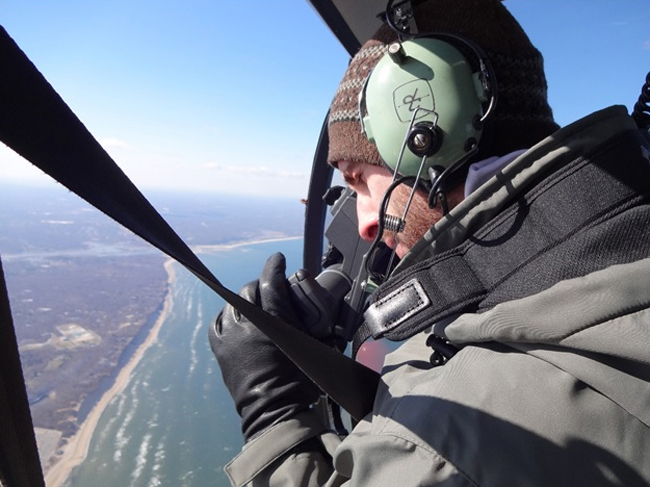
Joseph Tamborski, a former Stony Brook University geosciences graduate student, takes flight in a helicopter and looks out over Smithtown Bay in February 2013. The parking lot in the lower left-hand corner is Long Beach, Town of Smithtown. While we cannot see submarine groundwater discharge (SGD) in this image (1) , photographic evidence of it is being captured by Tamborski’s thermal infrared camera and later combined with measurements from the ground. SGD is a hydrogeologic mechanism whereby water is pushed in different ways underground toward the sea, and vice versa. Credit: Joseph Tamborski
— By Chris Gonzales, Freelance Science Writer, New York Sea Grant
Stony Brook, NY, February 7, 2020 – A casual beachgoer might think that the sea rises to the edge of the land and stops there. However, if you look closely, you might notice that the water on the sea’s edge isn’t held in place by a boundary, but rather seeps into the sand. While less visible to the naked eye, groundwater filters through the beach sand and meets with water from rain, rivers, and streams, as well as with water from the sea. Collectively, scientists call this liquid pore water—the water, so to speak, in the pores of the beach sand. Scientists also tell us that groundwater and seawater are continually being mixed and exchanged.
One team of New York Sea Grant (NYSG)-funded investigators from Stony Brook University (SBU) – led by principal investigators Drs. Henry Bokuniewicz, J. Kirk Cochran (both from the School of Marine and Atmospheric Sciences, or SoMAS) and A. Deanne Rogers (from the Department of Geosciences) – is using chemistry to explore residence times, or how long it takes these processes of mixing and exchange to take place. It is important for the conservation of the coastal environment to understand these processes and the forces behind them.
“The mixing zone between groundwater and seawater in the coastal aquifer is critically important for controlling a variety of chemical reactions,” said Joseph Tamborski, a marine chemist who completed his PhD between Geosciences and SoMAS in 2016. “In the case of Long Island Sound, we are generally concerned about nitrogen, too much of which stimulates phytoplankton growth and can lead to adverse ecological conditions such as harmful algal blooms.”
What Chemical Clocks Can Tell
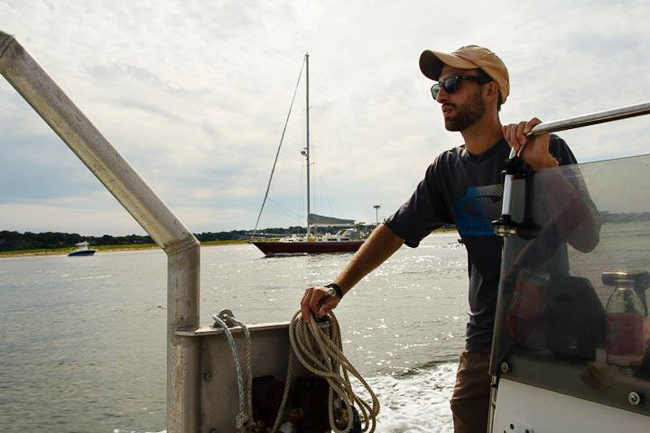
“We were opposite of Crane Neck in Smithtown Bay collecting coastal surface waters for radium isotopes,” said Tamborski of this circa 2015 photo. Credit: Joseph Tamborski
Tamborski and his fellow SBU investigators tracked the presence of naturally-occurring radioactive isotopes of radon and radium in two locations on Long Island where there exist subterranean estuaries (STEs), natural features where groundwater mixes with seawater. The radioactivities of these isotopes are relatively low and are considered harmless to humans.
“In the subterranean estuary, nitrogen in groundwater can be removed by biological processes—for example, denitrification; or nitrogen may merely be diluted by mixing with seawater,” said Tamborski. “Conversely, when seawater that is rich in organic matter infiltrates into beaches, nitrate can be generated. Such reactions depend on the residence time of the pore fluid beneath the subsurface; therefore, we use naturally occurring radionuclides as a ‘clock’ to determine the time-scale of this process.”
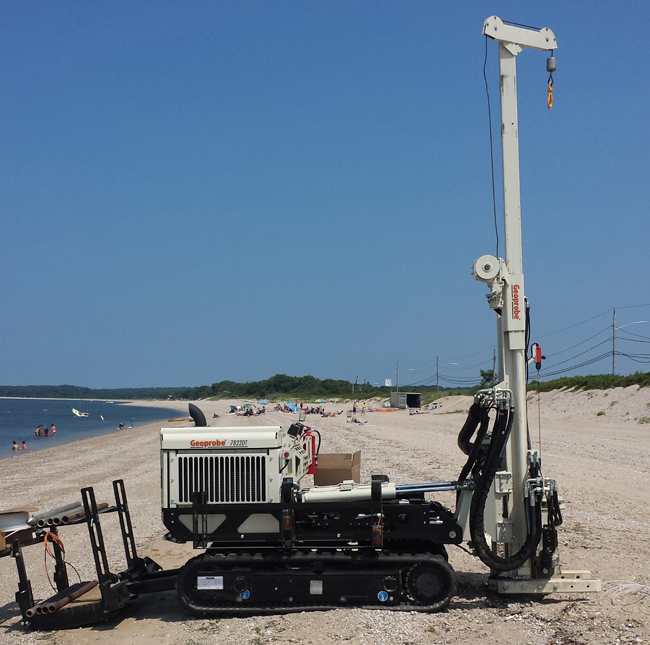
Suffolk County Department of Health Services provided a geoprobe in July 2014 to assist in the installation of wells into the sands at Long Beach, Town of Smithtown. Credit: Joseph Tamborski
The researchers spent more than a year taking measurements from two coastal sites on Long Island. The beachside locations included a barrier beach, with a sand bar parallel to the coastline. Another site was a coastal bluff, characterized by a steep slope.
Too Much of a Good Thing
In recent years, waters of Long Island have been experiencing periods of poor water quality conditions—hypoxia, or life-endangering conditions of low oxygen. In the past, waste-water treatment plants have been identified as main contributors of nitrogen, along with sources from industry and rivers. However, according to Tamborski (along with a growing number of scientists), the predominant source is in fact Long Island’s vast network of inadequate residential septic systems, along with contributions from fertilizer.
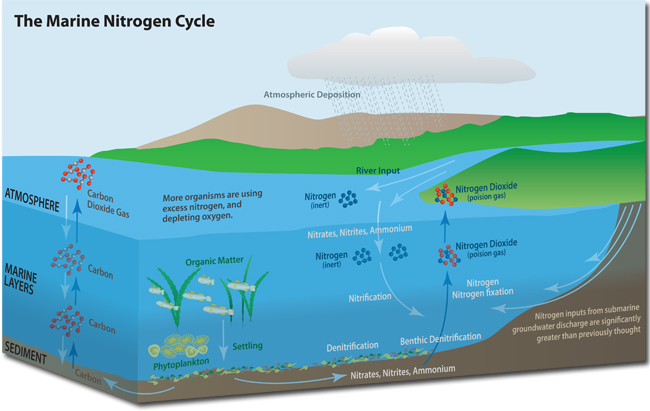
The marine nitrogen cycle. Credit: Loriann Cody
Visualizing the Marine Nitrogen Cycle
Interest in the marine nitrogen cycle has soared in the last two decades, owing to several converging factors, including the acceleration of the nitrogen cycle by humans (“The Green Revolution” in agriculture), the application of fertilizer to agricultural soils, and a growing awareness of the dynamic and fragile nature of the cycle itself. Furthermore, the nitrogen cycle carries implications for climate change.
Tamborski’s new work supports the idea that nitrogen is being added to the water from submarine groundwater discharge as a nutrient source for organisms such as harmful algae. These nutrients are harming coastal ecosystems, not only off the coast of Long Island, but globally.
Radium Isotopes as Tracers
Tamborski came across research proving that nitrogen inputs to the sea from SGD could rival that from rivers in some coastal environments. He decided to apply what he knew about radon and radium as potential tracers to the natural features called subterranean estuaries (STEs), the chemically active zones where groundwater and seawater mix.
Tamborski suspected that previous studies tended to downplay or ignore the significance of these submarine groundwater inputs of nitrogen.
A second study by Tamborski focused on the approximately 12-mile stretch of shoreline of Smithtown Bay—a popular fishing spot and boating destination on the Long Island Sound.
Tamborski sampled seawater for radon and radium isotopes to assess the volume of SGD entering Smithtown Bay.
As he did this, he also monitored water for general characteristics such as temperature, salinity and dissolved oxygen. He also collected samples of pore water.
The Serious Problem
Tamborski found an excess of radon and radium activities in surface water within 200 meters (660 feet) of the Smithtown Bay shoreline, indicating that SGD is occurring there. Furthermore, radon activities were greater in the summer. Where there is more radon and radium, there is likely more nitrogen inputs from SGD, from both terrestrial and marine sources.
However, low surface water nitrogen concentrations suggested there is a rapid biological utilization of nutrients. In other words, those nutrients are quickly consumed by living organisms such as microbes and phytoplankton. Tamborski considered the idea that this nitrogen loss might have been due to microbes other converting nitrate to nitrogen gas (denitrification), which can be released into the air. But the data do not support that idea.
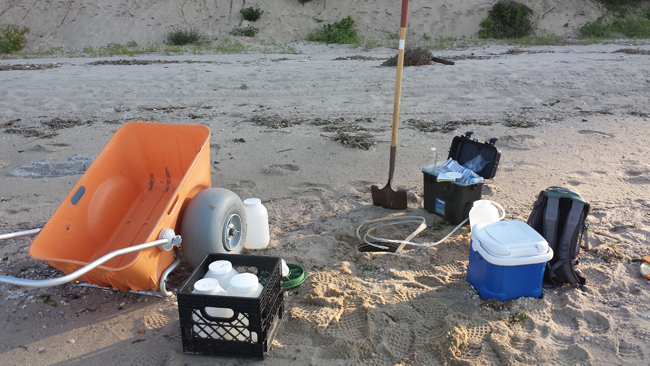
“The tubes in the center of the photograph are ‘cluster-wells,’” Tamborski said. “Each tube is connected to a slit PVC tube, and each tube is set to a different depth. The blue cooler is used to keep nutrient samples cold (on ice) immediately after collection. The intertidal wells were generally covered, hence the shovel to dig to try and find them.” Credit: Joseph Tamborski
Total SGD fluxes and nitrogen loads into Smithtown Bay, in fact, he found, are between two and five times greater than the flow of the nearby Nissequogue River.
In comparison, the sewage treatment plant in Kings Park (a hamlet of The Town of Smithtown) releases a tiny fraction of nitrogen to the bay. The SGD component, Tamborski found, is significantly greater.
It appears the primary sources of nitrate in the bay—and in the SGD—are from residential septic systems and recent fertilizer applications.
“Groundwater-borne nitrogen inputs may be an important driver in the development of summertime bottom water hypoxia in Smithtown Bay and parts of western Long Island Sound, in addition to previously identified factors,” said Tamborski.
“The monitoring of groundwater chemical fluxes is equally as important as monitoring riverine fluxes,” he added. “While this study is focused on Smithtown Bay, similar processes are at play all along Long Island’s south shore, where nitrogen inputs from groundwater play culprit to a host of environmental issues.”
“This work serves as a first step towards not only understanding what the current conditions are, but how we can remediate groundwater-driven nitrogen loads to Long Island Sound and Long Island's embayments.”
The bottom line: nitrogen inputs from SGD are significantly greater than previously thought, and those inputs are even more intense in the summer. This leads to biological uptake, oxygen consumption, and hypoxic events in Smithtown Bay. These findings are significant not only to Long Island Sound, as serious though this problem may be for our region. Even more significant, the findings carry a warning for preserving the environmental quality of the entire global ocean.
Footnotes
(1) For details about the use of infrared photography to detect SGD, see Tamborski, J., et al. (2015). Identification and quantification of diffuse fresh submarine groundwater discharge via airborne thermal infrared remote sensing. Remote Sensing of Environment 171 202-217.
References
Gruber, N. (2008). “The marine nitrogen cycle: Overview and challenges.” Center for Microbial Oceanography, University of Hawai‘i. http://cmore.soest.hawaii.edu/summercourse/2009/documents/Gruber_et_al._2008_N_Book.pdf
Loose, B. and Kelly, R. (2013). “Radon in the ocean’s basement.” Woods Hole Oceanographic Institution. https://www.whoi.edu/page.do?pid=125256
Smith, C. (2011). “Natural radium and radon tracers to quantify water exchange and movement in reservoirs.” US Geological Survey. https://pubs.er.usgs.gov/publication/70157933
Journal Articles
Bokuniewicz, H.J., J.K. Cochran, J. Garcia-Orellana, V. Rodellas, J.W. Daniel, and C. Heilbrun. 2015: "Intertidal percolation through beach sands as a source of 224,223Ra to Long Island Sound, New York, and Connecticut, United States" Journal of Marine Research, vol. 73, no. 5 ; page(s): 123-140
Tamborski, J.J., A.D. Rogers and H.J. Bokuniewicz. 2016: "Investigation of submarine groundwater discharge to tidal rivers: Evidence for regional and local scale seepage" - Hydrological Processes, vol. 31, no. 3; page(s): 716-730
Tamborski, J.J., A.D. Rogers, H.J. Bokuniewicz, J.K. Cochran, C.R. Young. 2015: "Identification and quantification of diffuse fresh submarine groundwater discharge via airborne thermal infrared remote sensing" Remote Sensing of Environment, vol. 171; page(s): 202-217
Tamborski, J., Cochran, J. and Bokuniewicz, H. (2017a). "Application of 224Ra and 222Rn for evaluating seawater residence times in a tidal subterranean estuary." Marine Chemistry. 189 (2017) 32–45.
Tamborski, J., Cochran, J. and Bokuniewicz, H. (2017b). “Submarine groundwater discharge driven nitrogen fluxes to Long Island Sound, NY: Terrestrial vs. marine sources.” Geochimica et Cosmochimica Acta 218 40–57.
More Info: New York Sea Grant
New York Sea Grant (NYSG), a cooperative program of Cornell University
and the State University of New York (SUNY), is one of 34 university-based
programs under the National Oceanic and Atmospheric Administration’s
National Sea Grant College Program.
Since 1971, NYSG has represented a statewide network of integrated
research, education and extension services promoting coastal community
economic vitality, environmental sustainability and citizen awareness
and understanding about the State’s marine and Great Lakes resources.
Through NYSG’s efforts, the combined talents of university scientists
and extension specialists help develop and transfer science-based
information to many coastal user groups—businesses and industries,
federal, state and local government decision-makers and agency managers,
educators, the media and the interested public.
The program maintains Great Lakes offices at Cornell University, SUNY
Buffalo, SUNY Oswego and the Wayne County Cooperative Extension office
in Newark. In the State's marine waters, NYSG has offices at Stony Brook
University in Long Island, Brooklyn College and Cornell Cooperative
Extension in NYC and Kingston in the Hudson Valley.
For updates on Sea Grant activities: www.nyseagrant.org has RSS, Facebook, Twitter, and YouTube links. NYSG offers a free e-list sign up via www.nyseagrant.org/nycoastlines for its flagship publication, NY Coastlines/Currents, which is published quarterly. Our program also produces an occasional e-newsletter,"NOAA Sea Grant's Social Media Review," via its blog, www.nyseagrant.org/blog.